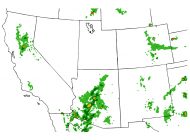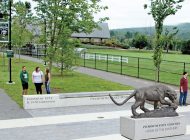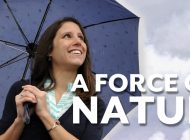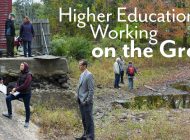by Barbra Alan
Dream big, work hard: this captures Patrick Selmer’s approach to both his education and his career. Just two months after finishing coursework for his Master of Science in Applied Meteorology at PSU in 2012, he landed a job with NASA, the world’s leading aeronautics and space research organization.
Less than three years later, on January 10, 2015, Selmer saw his first project launch into space.
Clouds and Climate
The project, dubbed the Cloud-Aerosol Transport System (CATS), is an instrument that’s part telescope and part laser, which measures clouds and the tiny liquid and solid particles, called aerosols, surrounding our planet. By measuring these clouds and aerosols in space, CATS will provide scientists with data that can help them better understand climate change here on Earth.
As part of a 19-member team of scientists and engineers, Selmer helped prepare the instrument for launch. Now that it’s in space, docked at the International Space Station, he programs commands, processes the data it relays back to NASA, and ensures that it’s functioning properly. “I find it surreal that I’m working at NASA as part of the CATS team,” says Selmer. “It has been an incredible experience and a great responsibility.”
Prior to his recruitment to the team as CATS operations lead in late 2013, Selmer served NASA in the field, traveling all over the world to retrieve and process data from Cloud Physics LIDAR and Airborne Cloud Aerosol Transport System—instruments that, like CATS, measure cloud and aerosol properties. “They are basically airborne versions of CATS, except they’re fitted to fly on research airplanes as opposed to orbiting on satellites,” he says.

“I chose PSU’s applied meteorology program because it was more job-oriented than other schools’ programs,” says Patrick Selmer, back right, testing CATS with a colleague. Photo courtesy of NASA.
Unique Opportunity
Selmer’s current role as CATS operations lead will keep him at the Goddard Space Flight Center in Greenbelt, MD, for as long as the instrument is operational, which could be anywhere from six months to three years. And while he enjoyed traveling to exotic places like Guam, he feels honored to be working on CATS, which has the potential to not only shed new light on climate change, but also to establish a new lower-cost, streamlined business model for NASA projects.
From 250 miles above the Earth’s surface, CATS is demonstrating how innovative science can be done for less money and with less time than what is typically allotted for such projects. The instrument, which is about the size of a refrigerator, was built within two years, with limited funds, and by a small team that included seasoned NASA scientists and engineers as well as early-career scientists, recent college graduates, and a few exceptional high school interns. The small team allowed younger members, like Selmer, to take on more responsibility than they would on bigger budget projects. He’s grateful for this unique opportunity so early in his career. “I’m a fairly young, relatively inexperienced recent college graduate,” says Selmer. “The head of the CATS team, Matthew McGill, saw potential in me, and trusted me to be able to do the work.”
Hard Work Pays Off
Selmer wasn’t completely new to NASA when he started working at Goddard Space Flight Center in 2012; he had done an internship there as an undergraduate. “I hoped that someday I could come back and work here full-time, but I never really expected it to happen,” he says. “I’m unbelievably lucky.”
In truth, luck had little if anything to do with his impressive career trajectory. Fascinated by weather from a young age, Selmer studied hard throughout high school and college and excelled in his science and math courses. When he had the opportunity to intern with NASA, he didn’t hesitate, and was determined to make the most of the experience. “I worked harder than I ever had in my life, to show that I could do good work,” he says.
When it came time for Selmer to pursue graduate study in meteorology, he searched for a program that would give him the skills necessary to launch a career in meteorology. One of his undergraduate professors recommended that he check out PSU. “I chose PSU’s applied meteorology program because it was more job-oriented than other schools’ programs; it had a strong focus on skill-building,” he says.
Although he worked hard at PSU, spending much of his time in Boyd Science Center, he also immersed himself in all the University had to offer, from enjoying its quiet rural setting, to shooting hoops with friends in the HUB, to playing clarinet with the Chamber Winds, and even jamming with some of his meteorology classmates in a rock band called the Falling Barometers.
Selmer applies much of what he learned at PSU to his work, skills including project management and the ability to work independently, as well as experience with working in computer operating systems including UNIX and with programming languages such as FORTRAN. “These skills were directly transferrable to my work, and helpful in teaching me how to problem-solve,” he says.
While he still sometimes finds it hard to believe he’s working for NASA on a project that will provide scientists with a greater understanding of our planet, Selmer is looking forward to a long and fulfilling career doing just that. “I hope to continue working on projects like CATS that will advance our understanding of nature and help improve people’s lives—projects with meaning,” he says.
Learn more about PSU’s undergraduate and graduate programs in applied meteorology.
Tags: applied meteorology CATS Cloud-Aerosol Transport System Goddard Space Flight Center meteorology MS in Applied Meteorology NASA Patrick Selmer












